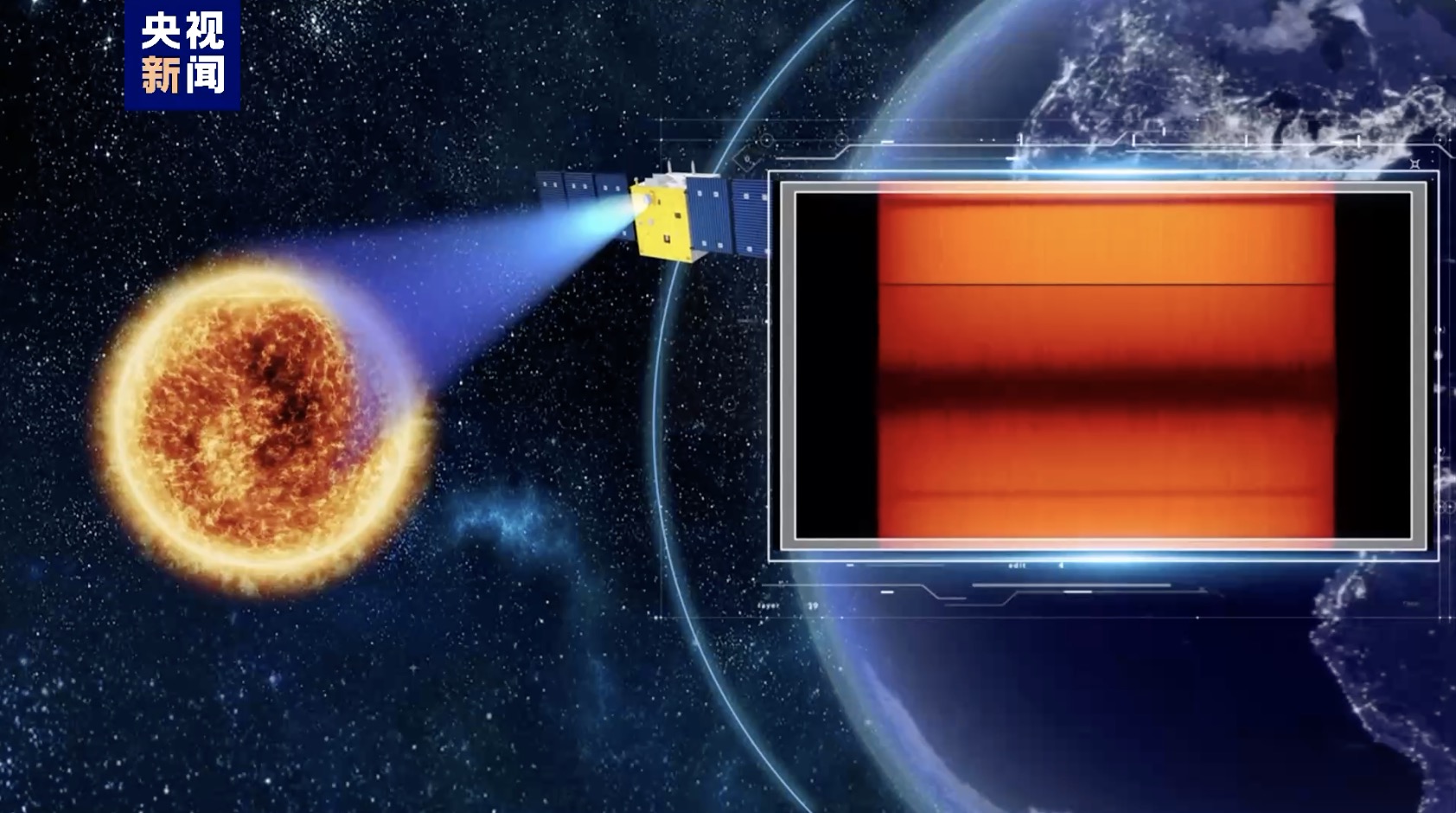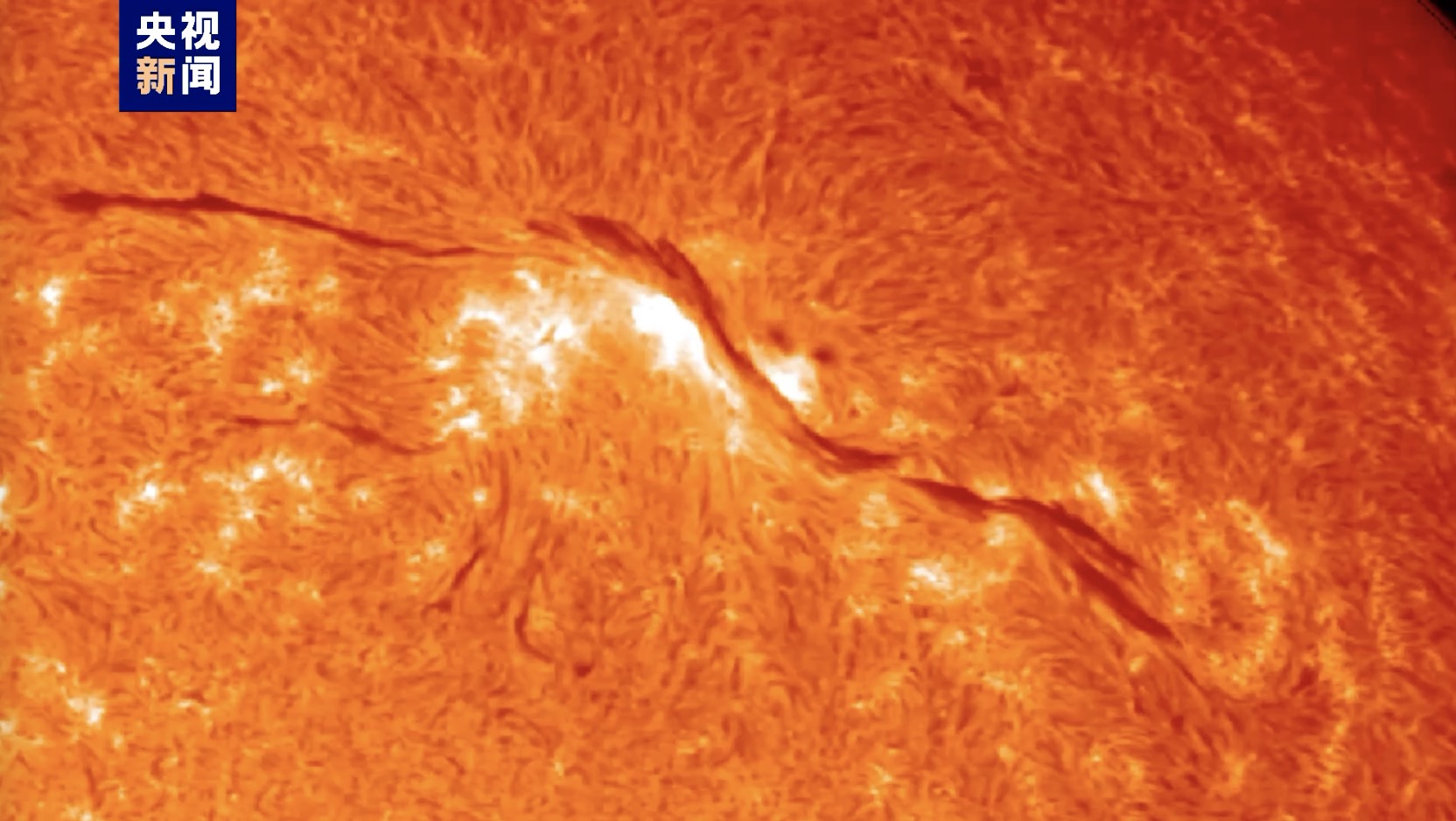
An illustration shows China's first solar exploration satellite Xihe observing the sun. /CMG
An illustration shows China's first solar exploration satellite Xihe observing the sun. /CMG
The Solar Science Data Center of Nanjing University in east China's Jiangsu Province released a batch of new observation data, showcasing the spectacular sights captured by China's first solar exploration satellite, Xihe, over the past two years, according to a report by China Media Group (CMG).
On October 14, 2021, Xihe was placed into a sun-synchronous orbit for conducting solar H-alpha spectral imaging.
The satellite is equipped with China's first solar telescope in space to observe the deep-red H-Alpha line of the solar spectrum, allowing scientists to study solar flares.
It is known as the Chinese H-Alpha Solar Explorer (CHASE), also named Xihe after the sun goddess in ancient Chinese mythology.
The satellite, weighing 550 kilograms and designed to have a three-year operational life, will remain in a fixed position relative to the sun as it observes, collects data, and creates solar images.
"It has ultra-high performance in direction pointing and maintaining stability," said Chen Jianxin, chief commander of the CHASE satellite, and also a researcher at the 8th Institute of China Aerospace Science and Technology Corporation.
"Just like when we shoot, we have to aim well and also keep our hands and body still to hit the target," he added.

An image of the sun, obtained by China's first solar exploration satellite Xihe, released by the Solar Science Data Center of Nanjing University in east China's Jiangsu Province. /CMG
An image of the sun, obtained by China's first solar exploration satellite Xihe, released by the Solar Science Data Center of Nanjing University in east China's Jiangsu Province. /CMG
Major breakthroughs
Over the past two years, Xihe has generated more than 400 terabytes of high-quality scientific data, along with a series of original research findings, according to CMG.
China released the results of Xihe with breakthroughs in technology verification and data shared with the international community.
The satellite has obtained the world's first H-alpha spectral scanning imaging with ultra-precision after observation on almost 100 solar burst activities.
"It is like a deep CT scan to the entire sun. And it aims to find the physical laws of the solar atmosphere and the solar activities," said Ding Mingde, chief scientist of Xihe solar observation satellite. "It will help us prevent the harms that the solar activities might bring to us."
The satellite made two key breakthroughs of "ultra-precision" and "super stability," according to Chen. "It increases one to two orders of magnitude compared with any satellites we are using now. That means a better environment for the payload of camera which enables better images."
And the probing results are open to scientists around the world and can be downloaded from the official website.
"Solar probe is the common cause of all human beings. We must take advantages of these data and resources to provide the bountiful research materials for the solar physicists around the world," said Zhao Jian, director of Earth Observation System and Data Center, China National Space Administration.
"This will help them find better scientific discoveries and better serve the human society."
Xihe-2 mission
China is also planning to launch a solar exploration satellite to a previously unexplored orbit between Earth and the sun for solar probe and space weather monitoring.
The appraisal work of Xihe-2 solar exploration mission to the Sun-Earth L5 Lagrangian Point is in the pipeline, said professor Fang Cheng from Nanjing University, who is also one of the satellite's designers.
In the initial plan, the solar probe is expected to be sent into the planned orbit around 2026.
The mission aims to explore the origin and evolution of the magnetic field in the solar active region and reveal the three-dimensional structure and physical mechanism of solar bursts.
The Sun-Earth Lagrangian L5 point, approximately 150 million kilometers away from Earth, is a uniquely advantageous location for space weather research and monitoring.
It enables imaging of solar activity at least three days prior to a terrestrial viewpoint and measures the solar wind conditions four to five days ahead of Earth impact.
The Xihe-2 satellite will be the world's first artificial probe to the point.
"The Sun-Earth L5 point is still a virgin place for exploration," said Fang. "It is scientifically meaningful and feasible in engineering."
It can also provide data for timely early warning and accurate forecasting of space weather, Fang added.